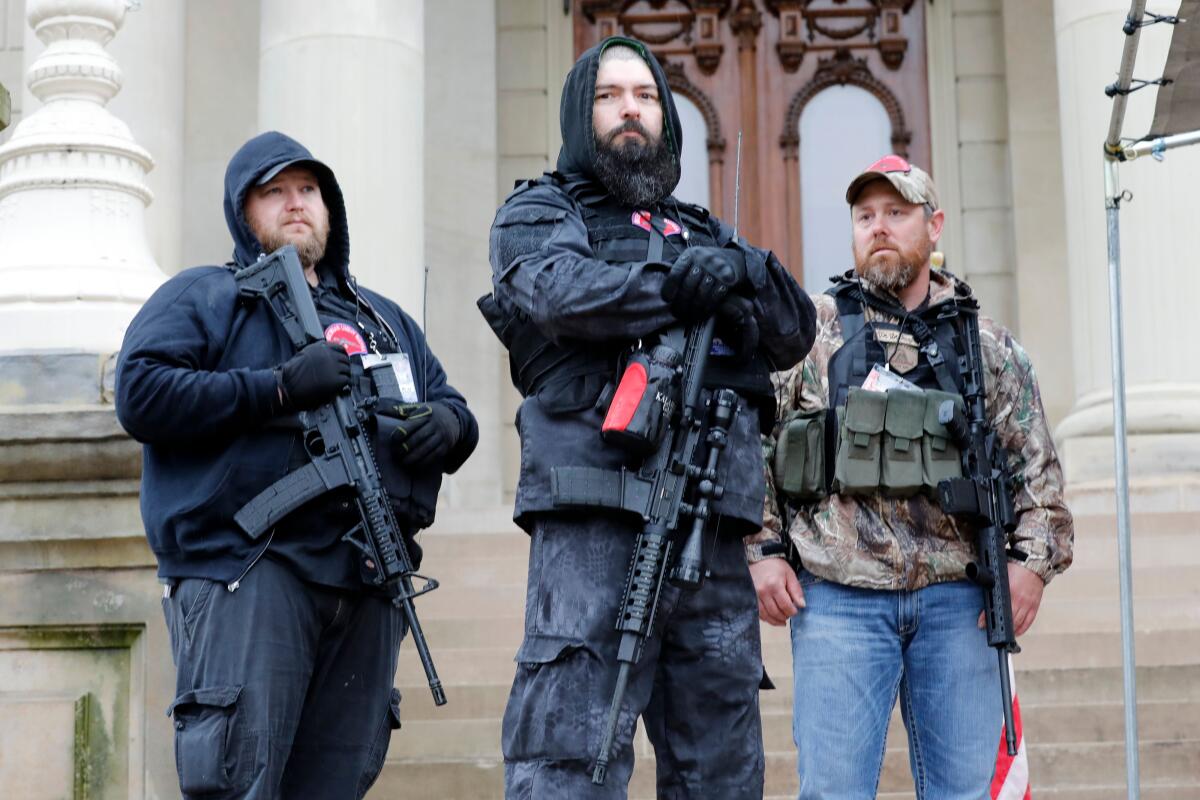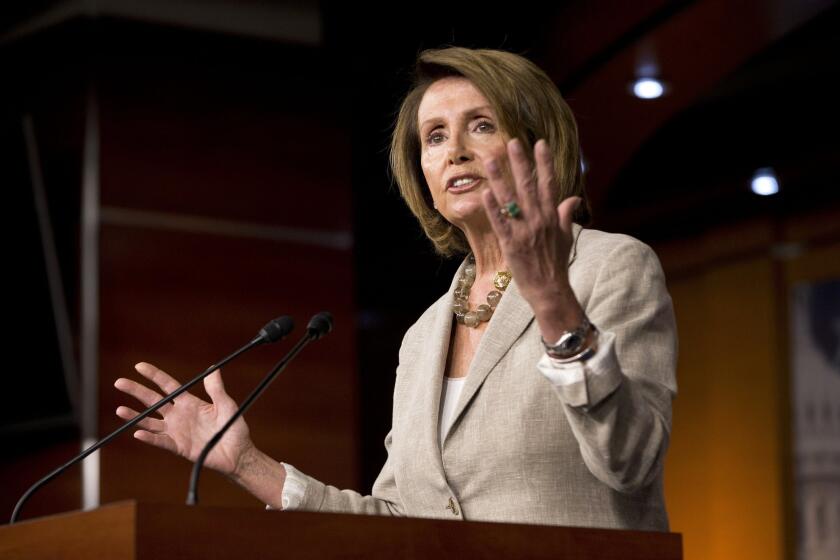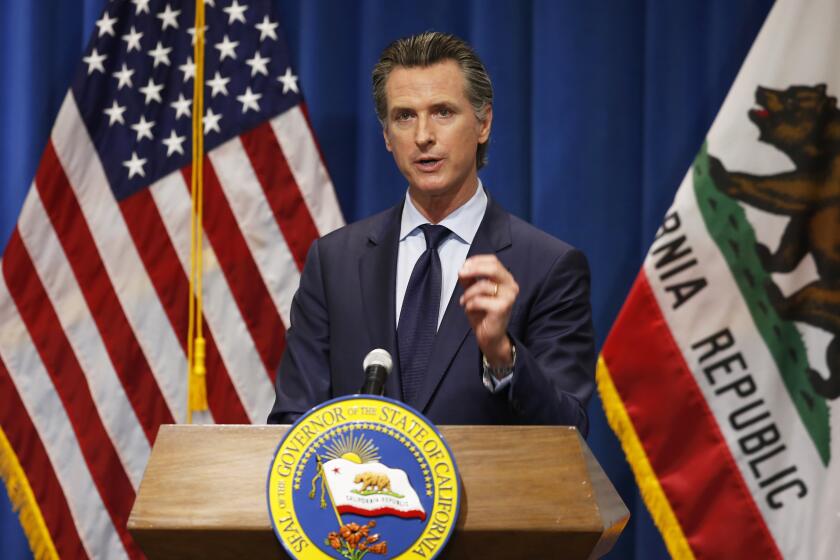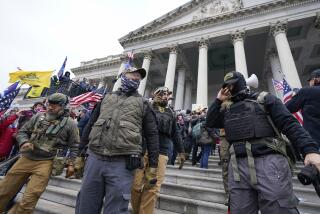Editorial: Planned protests by armed extremists should make states rethink their gun laws

- Share via
A Michigan state commission watched the events unfold in Washington, D.C., last week and, after years of resistance, decided Monday to ban the open carry of firearms in its own state Capitol, where armed opponents of pandemic restrictions crowded into the gallery last year seeking to intimidate legislators. That protest took on a darker tone when authorities later arrested half a dozen men — some of whom reportedly were at the Capitol that day — on charges they plotted to kidnap Gov. Gretchen Whitmer and put her on citizens trial.
Now the FBI warns that it believes far-right extremists are planning armed protests at each of the nation’s 50 state capitols over the coming days. The issue? The dangerous lies that President Trump in fact won the 2020 presidential election, and that there is a vast conspiracy to steal control of the country underway among sex traffickers, socialists and, who knows, maybe that guy behind the counter at the gas station. Many of these aggrieved and deluded Americans are too unhinged to be trusted with guns under any circumstances, but that’s another issue.
Censure isn’t enough to punish Trump for his role in the attack on the Capitol.
We take no issue with public protests or the right to freely assemble, agitate and even get a little loud. That’s part and parcel of the 1st Amendment right to free expression and to challenge government decisions. But it’s not a license to commit acts of violence or vandalism or to trample other people’s right to go about their daily business.
Or to amplify one’s speech with guns. Why do so many states allow people to walk around with semiautomatic rifles and other firepower in the first place? Such displays are not based on a desire for self-protection, as many proponents argue. As we’re seeing more and more, armed men — and they are overwhelmingly men — strutting around in pseudo-military gear carrying guns are intent on intimidation, not protecting themselves from an armed robber or whatever imagined threat their feverish psyche has cooked up.
We’ve argued before that, in general, allowing firearms at political demonstrations invites disaster, especially at a time when divisions run so deep and passions so high. It is only a matter of time before increasingly boisterous and violent demonstrations turn into massacres.
We saw the potential for such violence last week, when thousands of people descended on the U.S. Capitol at President Trump’s urging to try to stop Congress from certifying his reelection loss to President-elect Joe Biden. Many of those supporters stormed barricades to trash the seat of American democracy, physically assaulting police in the process and killing at least one of them. (Four other people died, including a woman shot by a Capitol Police officer as she clambered through the broken glass of a door to enter a barricaded section of the Capitol.) Washington, fortunately, has stringent gun control laws, and there were few firearms on display last week.
Yet only California, four other states and the District of Columbia generally bar people from carrying handguns openly in public, and only six states and D.C. ban carrying long guns (rifles and shotguns). The rest of the states range from having partial controls, such as requiring permits, to having no restrictions whatsoever. And as the pro-gun-control Giffords Law Center points out, armed people on the streets “can create substantial confusion for law enforcement officers, impeding their ability to protect public safety.”
The most important job of California lawmakers right now is to prevent the income inequality gap from widening as a result of the pandemic.
After the assassinations of the Kennedy brothers and Martin Luther King Jr. (and the self-arming of the Black Panthers in Oakland) in the 1960s, the nation began embracing practical approaches to who can own guns, who can carry them and where. But under pressure from the gun lobby and enthusiasts, states began some three decades ago to roll back many of those restrictions. And as the National Rifle Assn. turned from a gun-safety organization into an advocate of an extreme and hardline view of the 2nd Amendment, we saw the rise of the narrative that individuals needed to own firearms to protect themselves — not just from crime, but also from a tyrannical government.
Now we live with the results. Armed extremists are carrying firearms to political protests around the country, entering legislatures with them as an act of intimidation, bellowing conspiracy theories and claiming that the good people of the United states must rise up and defend the homeland against government tyranny in the form of a democratically elected president.
States must reject this romanticized notion that somehow the open carrying of firearms makes us a safer society, and policymakers must act as if public safety matters more than gun zealots’ warped view of the Constitution. We know tyranny when we see it, and it’s not when the government tries to slow the spread of a deadly disease or honor the will of the voters.
More to Read
A cure for the common opinion
Get thought-provoking perspectives with our weekly newsletter.
You may occasionally receive promotional content from the Los Angeles Times.












